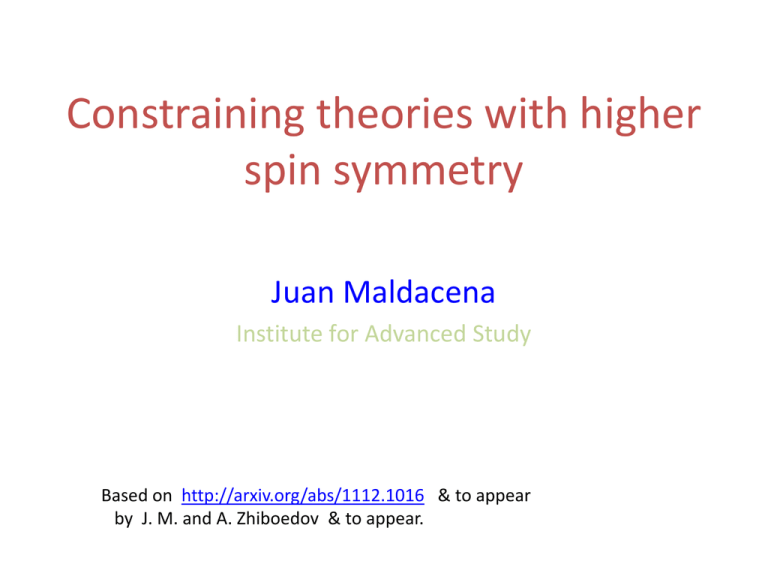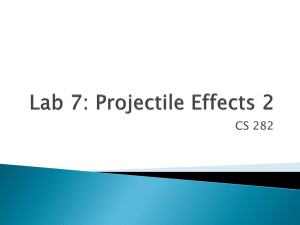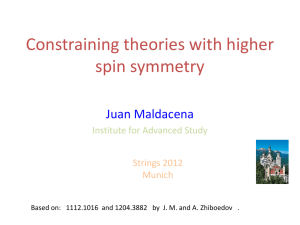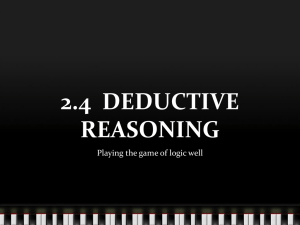Sildes
advertisement

Constraining theories with higher spin symmetry Juan Maldacena Institute for Advanced Study Based on http://arxiv.org/abs/1112.1016 & to appear by J. M. and A. Zhiboedov & to appear. • Elementary particles can have spin. • Even massless particles can have spin. • Interactions of massless particles with spin are very highly constrained. Spin 1 = Yang Mills Spin 2 = Gravity Spin s>2 (higher spin) = No interacting theory in asymptotically flat space • Coleman Mandula theorem : The flat space S-matrix cannot have any extra spacetime symmetries beyond the (super)poincare group. Needs an S-matrix. Higher spin gauge symmetries become extra global symmetries of the S-matrix. • Yes go: Vasiliev: Constructed interacting theories with massless higher spin fields in AdS4 . Witten Sundborg Sezgin Sundell Polyakov – Klebanov Giombi Yin … • AdS4 dual to CFT3 • Massless fields with spin s ≥ 1 conserved currents of spin s on the boundary. • Conjectured CFT3 dual: N free fields in the singlet sector • This corresponds to the massless spins fields in the bulk. • 1/N = ħ = coupling of the bulk gravity theory. The bulk theory is not free. • What are the CFT’s with higher spin symmetry (with higher spin currents) ? • We will answer this question here: • They are simply free field theories • This is the analog of the Coleman Mandula theorem for CFT’s, which do not have an Smatrix. • We will also constrain theories where the higher spin symmetry is “slightly broken”. Why do we care ? • This is an interesting phase of gravity, or spacetime. • Any boundary CFT that has a weak coupling limit has a higher spin conserved currents at zero coupling. • In examples, such as N=4 SYM, this is smoothly connected to the phase where the higher spin fields are massive. Presumably by some sort of Higgs mechanism. • In weakly coupled string theory, at high energies, we expect to have higher spin ``almost massless’’ fields. So it is interesting to understand the implications of this spontaneously broken symmetry. • We will not address these more interesting questions here. We will just address the more restricted question posed in the previous slide. • Vasiliev theory + boundary conditions that break the higher spin symmetry Dual to the large N Wilson Fischer fixed point… Polyakov – Klebanov Giombi Yin • Two approaches to CFT’s : - Write Lagrangian and solve it in perturbation theory - Bootstrap: Use the symmetries to constrain the answer. Works nicely when we have a lot of symmetry. • We can also view this as constraining the asymptotic form of the no boundary wavefunction of the universe in AdS. Assumptions • We have a CFT obeying all the usual assumptions: Locality, OPE, existence of the stress tensor with a finite two point function, etc. • The theory is unitary • We have a conserved current of spin, s>2. • We are in d=3 • (We have only one conserved current of spin 2.) Conclusions • There is an infinite number of higher spin currents, with even spin, appearing in the OPE of two stress tensors. • All correlators of these currents have two possible forms: • 1) Those of N free bosons in the singlet sector • 2) Those of N free fermions in the singlet sector Outline • Unitarity bounds, higher spin currents. • Simple argument for small dimension operators • Outline of the full argument • Then: cases with slightly broken higher spin symmetry. Unitarity bounds • Scalar operator: Δ ≥ ½ (in d=3) Bounds for operators with spin • Operator with spin s . (Symmetric traceless indices) • Bound: Twist = Δ -s ≥ 1 . • If Twist =1 , then the current is conserved • We consider minus components only: Spin s-1 , Twist =0 Removing operators in the twist gap • Scalars with 1 > Δ ≥ ½ • Assume we have a current of spin four. • The charge acting on the operator can only give (same twist only scalars ) • Charge conservation on the four point function implies (in Fourier space) Of course we also have: • This implies that the momenta are equal in pairs the four point function factorizes into a product of two point functions. • We can now look at the OPE as 1 2 , and we see that the stress tensor can appear only if Δ=½ . • So we have a free field ! • Intuition: Transformation = momentum dependent translation momenta need to be equal in pairs. Same reason we get the Coleman Mandula theorem ! • Observations: • We need to constrain both the correlators and the action of the higher spin symmetry. Of course three point functions determine the action of the symmetry. • We used twist conservation and unitarity to constrain the action of the generator. • Then we used this to constrain the correlators. Twist one • Now we have: • Sum over S’’ has finite range • Some c’s are non-zero , e.g. Structure of three point functions • Three point functions of three conserved currents are constrained to only three possible structures: - Bosons Giombi, Prakash, Yin - Fermions Costa, Penedones, Poland, Rychkov - Odd (involves the epsilon symbol). - We have more than one because we have spin - The theory is not necessarily a superposition of free bosons and free fermions (think of s=2 !) Brute Force method • Acting with the higher spin charge, and writing the most general action of this higher spin charge we get a linear combination of the rough form Coefficients in Transformation law • The three point functions are constrained to three possible forms by conformal symmetry lead to a large number of equations that typically fix many of the relative coefficients of various terms. • The equations separate into three sets, one for the bosons part, one for the fermion part and one for the odd part. • In this way one constrains the transformation laws. • Then one constrains the four point function. • Same as in a theory with N bosons or fermions. One can also show that N is an integer. Quantization of Ñ, or the coupling in Vasiliev’s theory • We can show that the single remaining parameter, call it Ñ, is an integer. • It is simpler for the free fermion theory • It has a twist two scalar operator • Consider the two point function of • If Ñ is not an integer some of these are negative. • So Ñ=N Conclusions • Thus, we have proven the conclusion of our statement. Proved the Klebanov-Polyakov conjecture (without ever saying what the Vasiliev theory is !). • Generalizations: - More than one conserved spin two current expect the product of free theories (we did the case of two) - Higher dimension. Almost conserved higher spin currents • There are interesting theories where the conserved currents are conserved up to 1/N corrections. • Vasiliev’s theory with bounday conditions that break the higher spin symmetry • N fields coupled to an O(N) chern simons gauge field at level k. • ‘t Hooft-like coupling Giombi, Minwalla, Prakash, Trivedi, Wadia, Yin Aharony, Gur-Ari, Yacoby Giombi, Minwalla, Prakash, Trivedi, Wadia, Yin Aharony, Gur-Ari, Yacoby Fermions + Chern Simons (6.20), (6.14). All t hat remains is t he int egral of t he right hand side of (7.1). In order for t his t o vanish, we need t hat 2 • Spectrum of ``singlea trace’’ operators as in the(7.3) = − a . 5 free case. So t his relat ive coefficient is fixed in t his simple way, for all λ, t o leading order in 1/ N . This a somewhat t rivial result since it also follows from demanding hattot he • isViolation of current conservation: (2pt fnstset 1 ) special 2 1 conformal generat or K − annihilat es t he right hand side of (7.1). We have spelled it out in order t o illust rat e t he use of t he broken symmet ry. Breaks parity As a less t rivial example, consider t he insert ion of t he same broken charge conservat ion ident ity in t he t hree point funct ion of t he st ress t ensor. We will do t his t o leading order • Insert this into correlation functions in λ. We get i Si a1 j −n − − j 2 (x 1 )j 2 (x 2 )j 2 (x 3 ) ∼ √ N d3 x [∂ ˜j 0 j 2 − 2˜ j 0 ∂j 2 ](x)j 2 (x 1 )j 2 (x 2 )j 2 (x 3 ) . 5 (7.4) Now let ’s t ake t he large N limit in t his equat ion. In t he left hand side we can subst it ut e t he act ion of t he charges on each of t he operat ors. This gives • Conclusion: All three point functions are • Two parameter family of solutions • We do not know the relation to the microscopic parameters N, k. • As we can rescale the operator and we get the large N limit of the Wilson Fischer fixed point. • The operator becomes the operator which has dimension two (as opposed to the free field value of one). It also becomes parity even. Discussion • In principle, it could be extended to higher point functions… Future • It is interesting to consider theories which have other ``single trace” operators (twist 3) that can appear in the right hand side of the divergence of the currents. (e.g. Chern Simons plus adjoint fields). • These are Vasiliev theories + matter. • What are the constraints on “matter’’ theory added to a system with higher spin symmetry?. Conjecture : String theory-like. • Of course, this will be an alternative way of doing usual perturbation theory. The advantage is that one deals only with gauge invariant quantities. Conclusions • Proved the analog of Coleman Mandula for CFT’s. Higher spin symmetry Free theories. • Used it to constrain Vasiliev-like theories • A similar method constrains theories with a higher spin symmetry violated at order 1/N. A final conjecture • Assume that we have a theory in flat space with a weakly coupled S-matrix. • The the theory contains massive higher spin fields , s > 2 . • The tree level S-matrix does is well behaved at high energies. • Then it should be a kind of string theory.









